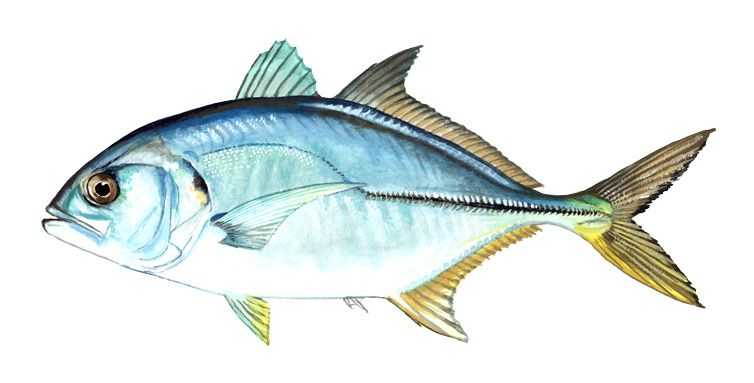Blue Runner

Species Details
Caranx Crysos
Carangidae
Perciformes
Onshore, Offshore, Reef
5 - 11 lbs.
13" - 28"
How can I identify a Blue Runner?
Blue Runners can be identified by their slender, elongated body, blue-green color on the back, silvery-white belly, deeply forked tail, and prominent lateral line. They also have a protruding lower jaw and small finlets behind their dorsal and anal fins.
Blue Runner (Caranx crysos) Fish Description
Also known as Egyptian scad, hardtail jack, green jack, black jack, bluestripe jack, or hardnose, the Blue Runner species belongs to the jack family (Carangidae). Blue Runners are highly similar to their fish cousins; they have elongated bodies and slightly pointed snouts. The dorsal fin of Blue Runners is composed of two parts: the first part has 8 spines, while the other consists of around 20 soft rays.
They are generally shiny because their bodies are fully covered with scales. Their color varies from being olive or bluish-green to silvery grey. They have golden bellies and prominently forked tails with black-colored tips. Another distinct feature Blue Runners have is the black spot on their gill cover.
Blue Runners are highly edible, affordable, and abundant, making them an important species in commercial fisheries or markets. Apart from being food, anglers also use them as bait.
Blue Runners are similar to bluefish, crevalle jack, and other species from the jack family.
Diet and Size
Blue Runners prey on small fishes found in inshore waters. They also feed on shrimps, crabs, and other crustaceans and invertebrates like lobsters and jellyfish. The juvenile Blue Runners prefer zooplanktons.
Compared to other species from the jack or Carangidae family, the Blue Runner is a little larger. They weigh 11 pounds on average and grow up to 27 inches.
Interesting Facts
- Blue Runners are a predatory species.
- Their upper jaw contains a series of outer, irregularly-shaped canines whereas their lower jaw consists of a single row of small teeth.
Blue Runner — Fishing Techniques
They are used as bait for the larger and premium fishes, but Blue Runners are quite hard to catch. Anglers must use tough main lines to secure and overcome the strength of the blue runners. They are best caught using a hook and line, but anglers may also opt for a rig.
Due to the Blue Runner's strength, anglers must weigh them down using an object that is at least 2 ounces heavy. They should also throw chum or any angling bait near the boat while continuing to hook and line the Blue Runners. To attract them, anglers may use mackerel, shrimp, or squid as bait. The best thing about Blue Runners is that they can be caught all year-round especially during October in northwest Florida. Their peak season in their other habitats is from January to August.
Habitat and Distribution
Blue Runners are typically found in the Atlantic Ocean and the Mediterranean. They adore tropical and temperate waters; thus, many of them can be found in the western African and European coastlines as well as the Central American coastline. They are aplenty from the Gulf of Mexico to Nova Scotia in Canada.
Blue Runners are an inshore species of fish; however, they also live on reefs as deep as or deeper than 100 meters. They are semi-pelagic and inhabit both inshore reefs and the upper slopes of deeper reefs. Studies have discovered that some Blue Runners are even found in extremely deep waters up to 2,500 meters. The young Blue Runners can be found offshore more than the adults who usually remain inshore.







